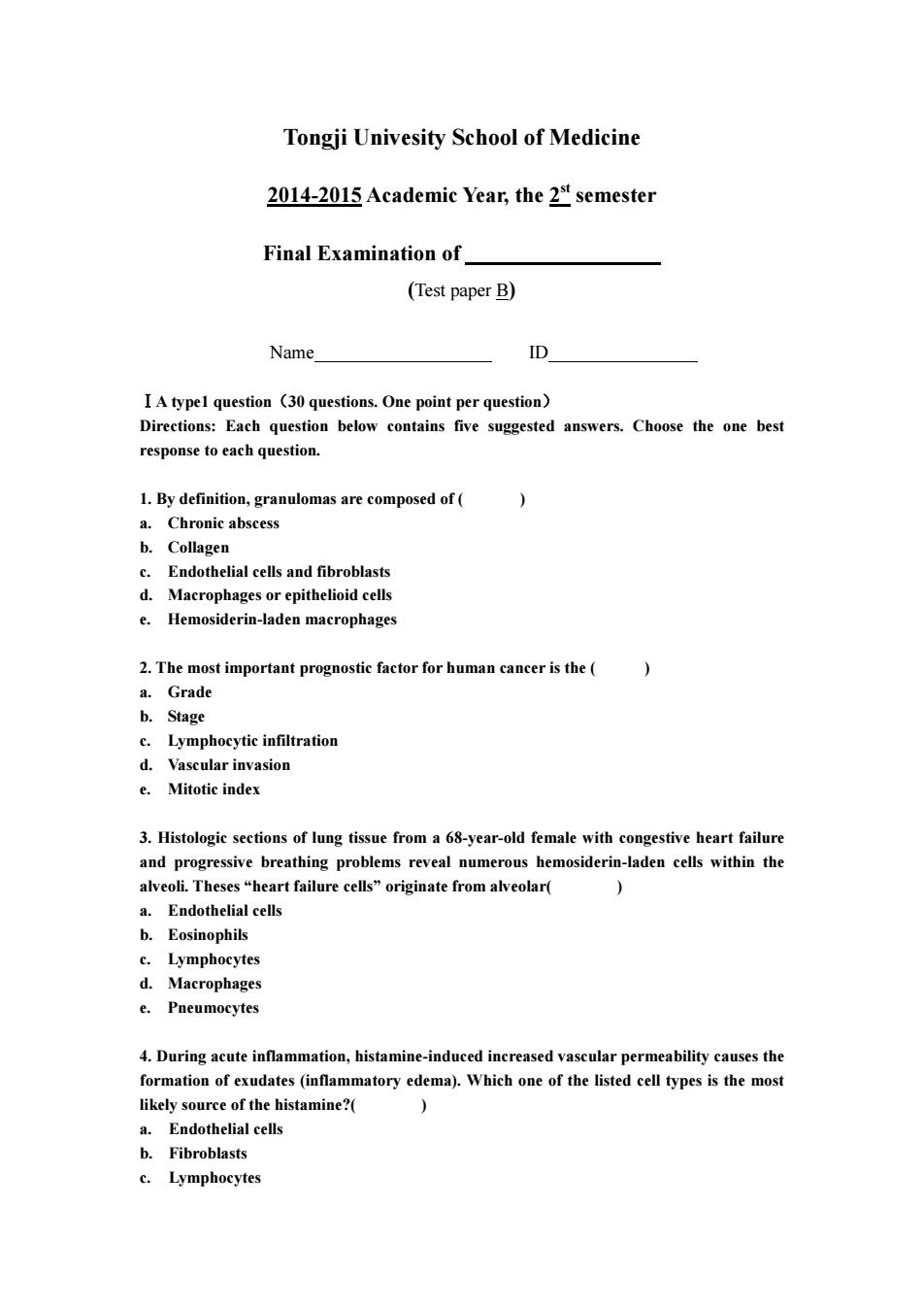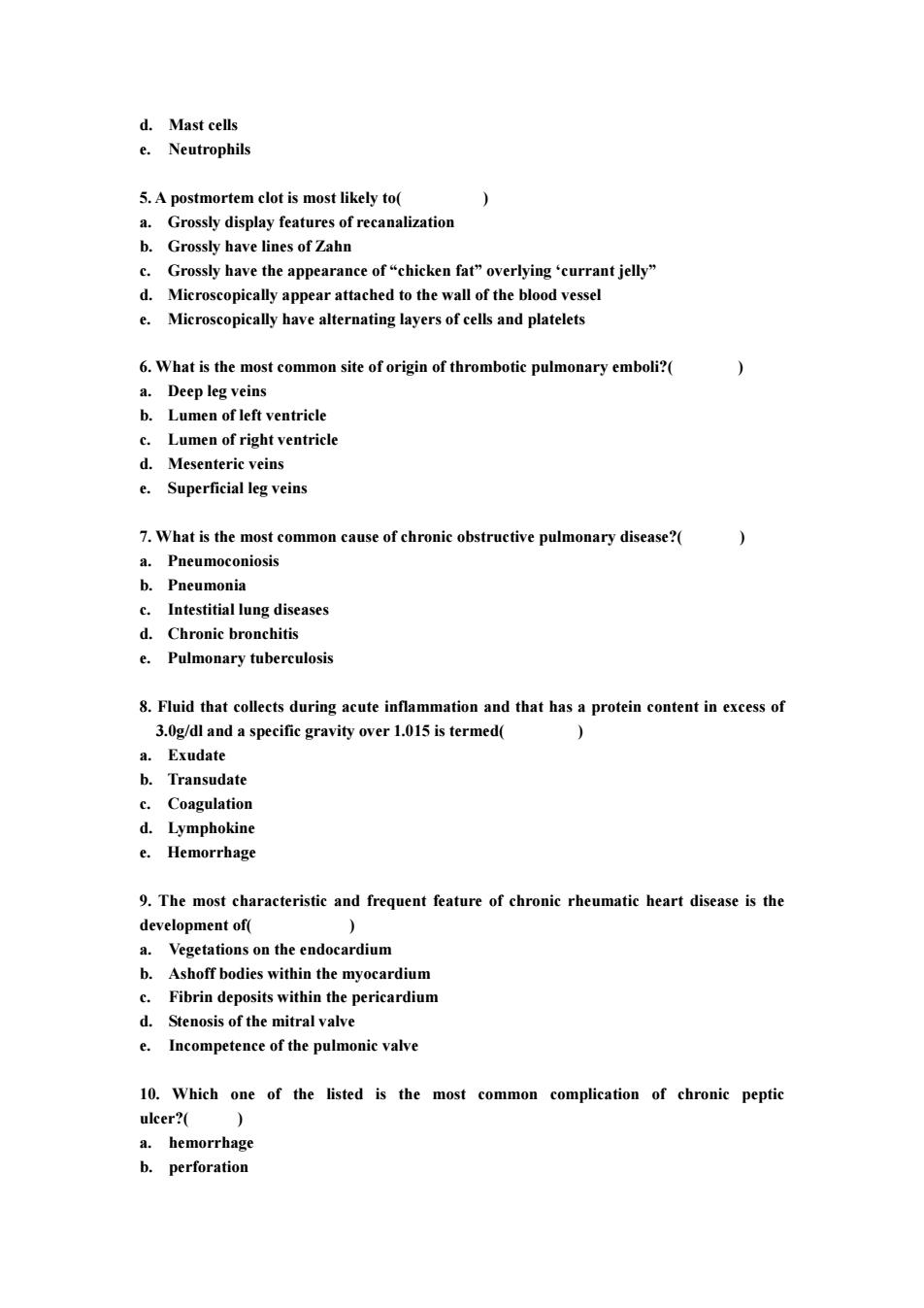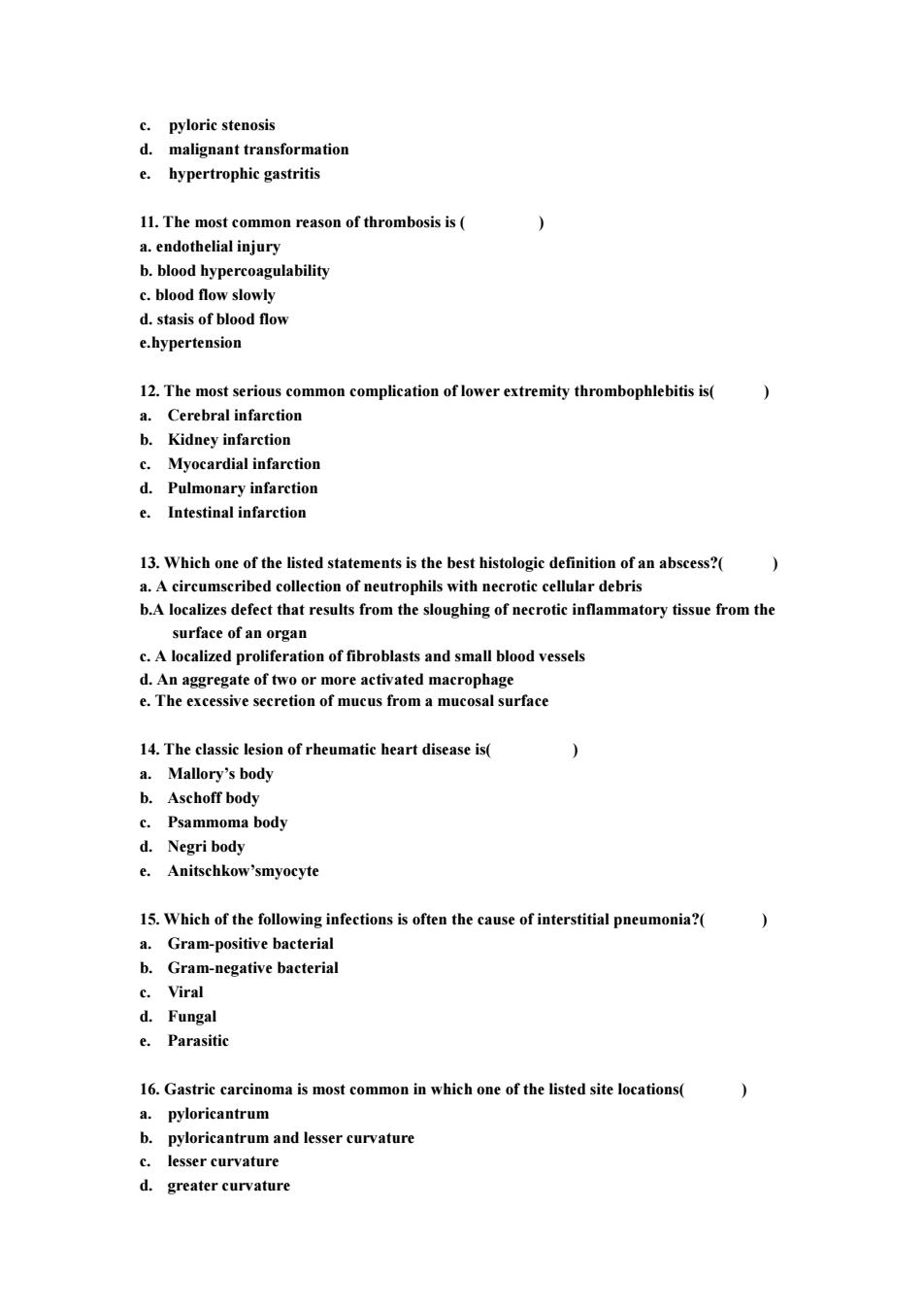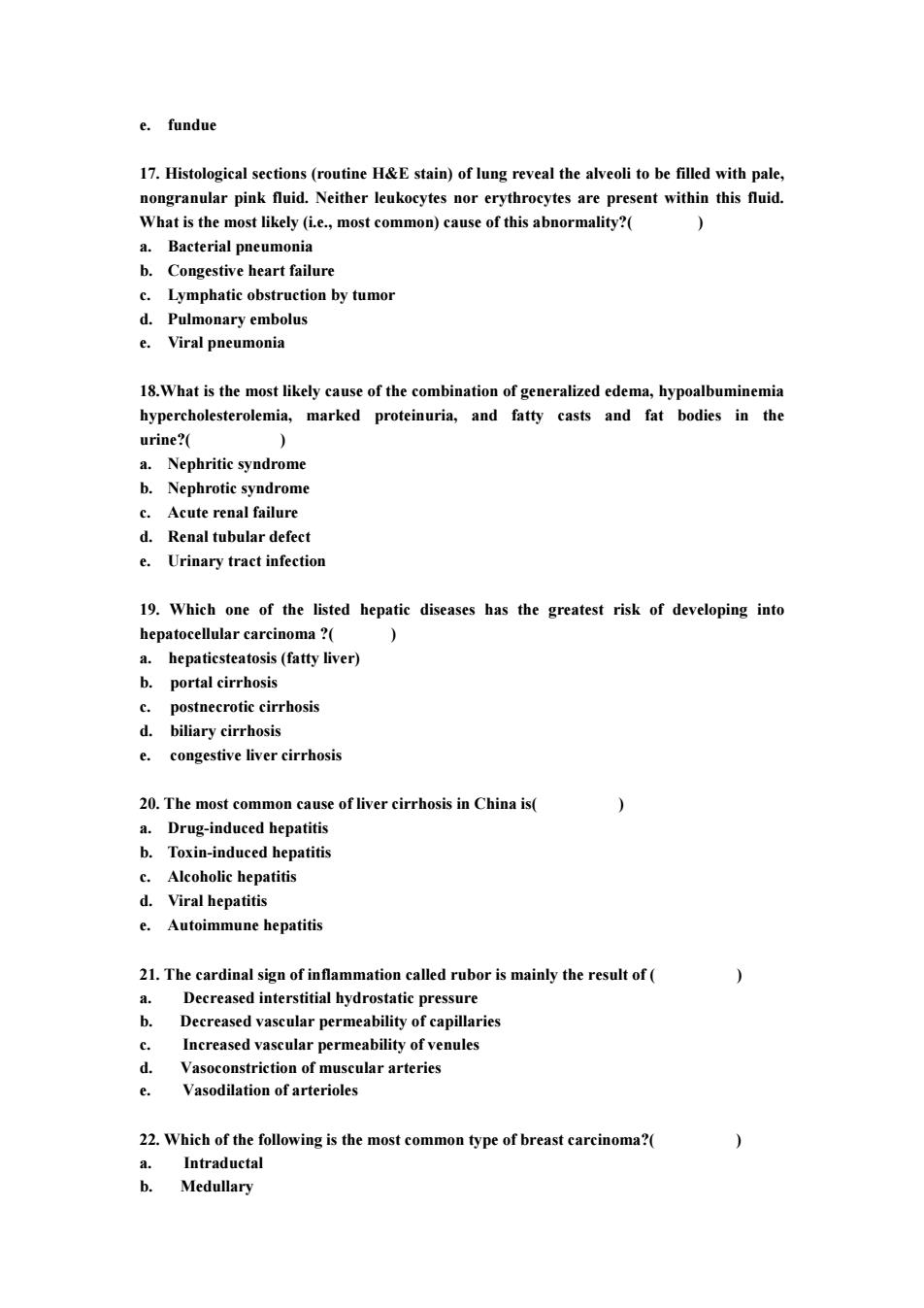
Tongji Univesity School of Medicine 2014-2015 Academic Year,the 2*semester Final Examination of (Test paper B) Name. ID IA typel question (30 questions.One point per question) Directions:Each question below contains five suggested answers.Choose the one best response to each question 1.By definition,granulomas are composed of( a.Chronic abscess b.Collagen c.Endothelial cells and fibroblasts e.Hemosiderin-laden macrophages 2.The most important prognostic factor for human cancer is the( a.Grade b.Stage c.Lymphocytic infiltration d.Vascular invasion e.Mitotic index 3.Histologic sections of lung tissue froma68-year-old female with congestive heart failure and progressive breathing problems reveal numerous hemosiderin aden cel业s within the alveoli.Theses "heart failure cells"originate from alveolar( a.Endothelial cells b.Eosinophils c.Lymphocytes d.Macrophage e.Pneumocytes 4.During acute inflammation,histamine-induced inereased vascular permeability causes the formation of exudates(inflammatory edema).Which one of the listed cell types is the most eof the histamine? ) Endothelial cells b.Fibroblasts c.Lymphocytes
Tongji Univesity School of Medicine 2014-2015 Academic Year, the 2 st semester Final Examination of __________________ (Test paper B) Name ID ⅠA type1 question(30 questions. One point per question) Directions: Each question below contains five suggested answers. Choose the one best response to each question. 1. By definition, granulomas are composed of ( ) a. Chronic abscess b. Collagen c. Endothelial cells and fibroblasts d. Macrophages or epithelioid cells e. Hemosiderin-laden macrophages 2. The most important prognostic factor for human cancer is the ( ) a. Grade b. Stage c. Lymphocytic infiltration d. Vascular invasion e. Mitotic index 3. Histologic sections of lung tissue from a 68-year-old female with congestive heart failure and progressive breathing problems reveal numerous hemosiderin-laden cells within the alveoli. Theses “heart failure cells” originate from alveolar( ) a. Endothelial cells b. Eosinophils c. Lymphocytes d. Macrophages e. Pneumocytes 4. During acute inflammation, histamine-induced increased vascular permeability causes the formation of exudates (inflammatory edema). Which one of the listed cell types is the most likely source of the histamine?( ) a. Endothelial cells b. Fibroblasts c. Lymphocytes

d.Mast cells e.Neutrophils 5.A postmortem clot is most likely to( a.Grossly display features of recanalization h.Grossly have lines of Zahn Grossly have the appearance of"chicken fat"overlying'curant jelly" Microscopically appear attached to the wall the blood vesse e.Microscopically have alternating layers of cells and platelets 6.What is the most common site of origin of thrombotic pulmonary emboli?( a.Deep leg veins b.Lumen of left ventricle Lumen of right ventricl d.Mesenteric veins e.Superficial leg veins 7.What is the most of chronic obstructive pulmonary disease?( c.Intestitial lung diseases d.Chronie bronchitis e.Pulmonary tuberculosis 8.Fluid that colleets during acute infammation and that has a protein content in excess of 3.0g/dl and a specific gravity over 1.015 is termed( a.Exudate b.Transudate Lymphokin e.Hemorrhage 9.The most characteristic and frequent feature of chronic rheumatic heart disease is the development of Vegeta ns on the e end cardium Ashoff bodies within the myocardium c.Fibrin deposits within the pericardium d.Stenosis of the mitral valve e.Incompetence of the pulmonic valve 10.Which one of the listed is the most common complication of chronic peptic ulcer?( a.hemorrhage b.perforation
d. Mast cells e. Neutrophils 5. A postmortem clot is most likely to( ) a. Grossly display features of recanalization b. Grossly have lines of Zahn c. Grossly have the appearance of “chicken fat” overlying ‘currant jelly” d. Microscopically appear attached to the wall of the blood vessel e. Microscopically have alternating layers of cells and platelets 6. What is the most common site of origin of thrombotic pulmonary emboli?( ) a. Deep leg veins b. Lumen of left ventricle c. Lumen of right ventricle d. Mesenteric veins e. Superficial leg veins 7. What is the most common cause of chronic obstructive pulmonary disease?( ) a. Pneumoconiosis b. Pneumonia c. Intestitial lung diseases d. Chronic bronchitis e. Pulmonary tuberculosis 8. Fluid that collects during acute inflammation and that has a protein content in excess of 3.0g/dl and a specific gravity over 1.015 is termed( ) a. Exudate b. Transudate c. Coagulation d. Lymphokine e. Hemorrhage 9. The most characteristic and frequent feature of chronic rheumatic heart disease is the development of( ) a. Vegetations on the endocardium b. Ashoff bodies within the myocardium c. Fibrin deposits within the pericardium d. Stenosis of the mitral valve e. Incompetence of the pulmonic valve 10. Which one of the listed is the most common complication of chronic peptic ulcer?( ) a. hemorrhage b. perforation

c.pyloric stenosis d. malignant transformation e. hypertrophic gastritis 11.The most common reason of thrombosis is a.endothelial injury b.blood hyper agulability c.blood flo d.stasis of blood fov e.hypertension 12.The most serious common complication of lower extremity thrombophlebitis is( Kidney infa Myocardial infarction d.Pulmonary infarction e.Intestinal infarction 13.Which one of the listed statements is the best histologic definition of an abscess?( a.A circumscribed collection of neutrophils with necrotic cellular debris b.A localizes defect that results from the sloughing of necrotic inflammatory tissue from the surface of an organ c.A localized proliferation of fibroblasts and small blood vessels d.An aggregate of two or more activated macrophage e.The excessive secretion of mucus from a mucosal surface 14.The classic lesion of rheumatic heart disease is( Mallory's body b.Aschoff body c.Psammoma body d.Negri body e.Anitschkow'smyocyte 15.Which of the following infections is often the cause of interstitial pneumonia?( a.Gram-positive bacterial b.Gram-negative bacterial c.Viral d.Fungal e.Parasiti 16.Gastric carcinoma is most common in which one of the listed site locations( a.pyloricantrum b. pyloricantrum and lesser curvatur lesser curvature d.greater curvature
c. pyloric stenosis d. malignant transformation e. hypertrophic gastritis 11. The most common reason of thrombosis is ( ) a. endothelial injury b. blood hypercoagulability c. blood flow slowly d. stasis of blood flow e.hypertension 12. The most serious common complication of lower extremity thrombophlebitis is( ) a. Cerebral infarction b. Kidney infarction c. Myocardial infarction d. Pulmonary infarction e. Intestinal infarction 13. Which one of the listed statements is the best histologic definition of an abscess?( ) a. A circumscribed collection of neutrophils with necrotic cellular debris b.A localizes defect that results from the sloughing of necrotic inflammatory tissue from the surface of an organ c. A localized proliferation of fibroblasts and small blood vessels d. An aggregate of two or more activated macrophage e. The excessive secretion of mucus from a mucosal surface 14. The classic lesion of rheumatic heart disease is( ) a. Mallory’s body b. Aschoff body c. Psammoma body d. Negri body e. Anitschkow’smyocyte 15. Which of the following infections is often the cause of interstitial pneumonia?( ) a. Gram-positive bacterial b. Gram-negative bacterial c. Viral d. Fungal e. Parasitic 16. Gastric carcinoma is most common in which one of the listed site locations( ) a. pyloricantrum b. pyloricantrum and lesser curvature c. lesser curvature d. greater curvature

e.fundue 17.Histological sections(rouin H&E stain)of lung reveal the alveolito be filled with pale nongranular pink fluid.Neither leukocytes nor erythrocytes are present within this fluid. What is the most likely (i.e.,most common)cause of this abnormality?( a Racterial nneumonia b.Congestive heart failure Lymphatic obs ruction by tumor d.Pulmonary embolus e.Viral pneumonia 18.What is the most likely cause of the combination of generalized edema.hypoalbuminemia marked uria, and fat女y casts and fat bodies in the urine?( a.Nephritic syndrome b.Nephrotic syndrome c Acute renal failure d.Renal tubular defect e Urinary tract infection 19.Which one of the listed hepatic diseases has the greatest risk of developing into hepatocellular carcinoma ? a.hepaticsteatosis(fatty liver) b. portal cirrhosis postnecrotic cirrhosis d.biliary cirrhosis e.congestive liver cirrhosis 20.The most common cause of liver cirrhosis in China is( a.Drug-induced hepatiti b.Toxin-induced hepatitis c.Alcoholic hepatitis d.Viral hepatitis e.Autoim mune hepatitis 21.The cardinal sign of inflammation called rubor is mainly the result of( a. Decreased interstitial hydrostatic pressure b. Decreased vascular permeability of capillaries Increased vascular permeability of venules d. Vasoconstriction of muscular arteries e vasodilation of arterioles 22.Which of the following is the most common type of breast carcinoma?( Intraductal Medullary
e. fundue 17. Histological sections (routine H&E stain) of lung reveal the alveoli to be filled with pale, nongranular pink fluid. Neither leukocytes nor erythrocytes are present within this fluid. What is the most likely (i.e., most common) cause of this abnormality?( ) a. Bacterial pneumonia b. Congestive heart failure c. Lymphatic obstruction by tumor d. Pulmonary embolus e. Viral pneumonia 18.What is the most likely cause of the combination of generalized edema, hypoalbuminemia hypercholesterolemia, marked proteinuria, and fatty casts and fat bodies in the urine?( ) a. Nephritic syndrome b. Nephrotic syndrome c. Acute renal failure d. Renal tubular defect e. Urinary tract infection 19. Which one of the listed hepatic diseases has the greatest risk of developing into hepatocellular carcinoma ?( ) a. hepaticsteatosis (fatty liver) b. portal cirrhosis c. postnecrotic cirrhosis d. biliary cirrhosis e. congestive liver cirrhosis 20. The most common cause of liver cirrhosis in China is( ) a. Drug-induced hepatitis b. Toxin-induced hepatitis c. Alcoholic hepatitis d. Viral hepatitis e. Autoimmune hepatitis 21. The cardinal sign of inflammation called rubor is mainly the result of ( ) a. Decreased interstitial hydrostatic pressure b. Decreased vascular permeability of capillaries c. Increased vascular permeability of venules d. Vasoconstriction of muscular arteries e. Vasodilation of arterioles 22. Which of the following is the most common type of breast carcinoma?( ) a. Intraductal b. Medullary

Papillary e. Infiltrating ducta 23.Of the lesions listed below,which one is in accord with the feature of malignant tumor?( a.Anaplasia b.Aplasia s.Hyperplasia plasia 24.Which of the following tumor markers has been associated with the hepatocellula carcinoma?( a.CEA b.AFP c.Prostae-specific antigen d.Tyrosine enzyme e.Thyroglibulin antigen 25.Nutmeg liver is associated with( a.conestive liver cirrhosis b.portal cirrhos e.biliary cirrhosis d.postnecrotic cirrhosis e.pipe stem cirrhosis 26.Benign hypertension is characterized by: ) a.Fibrinoid necrosis of arterioles b.Atrophy of the muscular media of the arteries c.Fibroelastic thickening of whole arteriole walls d.Hyaline deposition in arteriole walls e.Sudden and severe increase in blood pressure 27.Gastric carcinoma:( is usually of s uamous cell typ is commoner in fema les than male occurs most commonly in the body of the stomach d.is commoner in Europe than China e.has a positive association with dysplasia of gastric mucosa 28.Which one of the listed lesion is tumour?( uloma Atheroma
c. Papillary d. Mucinous e. Infiltrating ductal 23. Of the lesions listed below, which one is in accord with the feature of malignant tumor?( ) a. Anaplasia b. Aplasia c. Hyperplasia d. Hypoplasia e. Metaplasia 24. Which of the following tumor markers has been associated with the hepatocellular carcinoma?( ) a. CEA b. AFP c. Prostae-specific antigen d. Tyrosine enzyme e. Thyroglibulin antigen 25. Nutmeg liver is associated with ( ) a. congestive liver cirrhosis b. portal cirrhosis c. biliary cirrhosis d. postnecrotic cirrhosis e. pipe stem cirrhosis 26. Benign hypertension is characterized by:( ) a.Fibrinoid necrosis of arterioles b.Atrophy of the muscular media of the arteries c.Fibroelastic thickening of whole arteriole walls d.Hyaline deposition in arteriole walls e.Sudden and severe increase in blood pressure 27. Gastric carcinoma:() a. is usually of squamous cell type b. is commoner in females than males c. occurs most commonly in the body of the stomach d. is commoner in Europe than China e. has a positive association with dysplasia of gastric mucosa 28. Which one of the listed lesion is tumour?( ) a. Granuloma b. Hematoma c. Atheroma